Religion: Religious Leaders Pre-1900
Gautama Buddha (563 or 480 BC to 483 or 400 BC)
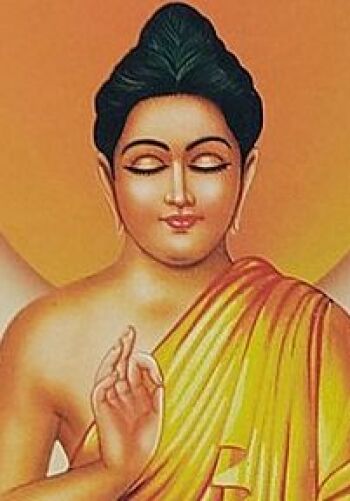
Religion and Branch: Buddhism
Title: Philosopher, Spiritual Leader
Gautama Buddha, commonly referred to as the Buddha, was a spiritual teacher who lived in ancient India, and he is the central figure in Buddhism.
Born as Siddhartha Gautama in Lumbini (in present-day Nepal) to the Shakya clan, the Buddha was raised in luxury as a prince. However, encounters with old age, sickness, death, and an ascetic led him to recognize the pervasive suffering in existence.
Leaving his princely life and family behind, Gautama embarked on a spiritual quest to understand the nature of suffering and the means to overcome it. After years of ascetic practices and meditation, he attained enlightenment under the Bodhi tree in Bodh Gaya, India, becoming the Buddha, which means "the awakened one."
The Buddha traveled widely across northern India, sharing his insights and teachings, which emphasized the Four Noble Truths and the Eightfold Path as the way to achieve Nirvana, or liberation from the cycle of birth and rebirth.
The Buddha established a monastic order (Sangha) comprising monks (bhikkhus) and nuns (bhikkhunis). This Sangha played a crucial role in preserving and propagating his teachings after his death.
Buddhism, as founded by the Buddha, became one of the major religions in ancient India. It received royal patronage from rulers like Emperor Ashoka, who spread Buddhism not just throughout India but also beyond its borders.
While Buddhism began to decline in India around the end of the first millennium AD due to various reasons, including the Muslim conquests and the resurgence of Hinduism, its principles had already spread to other parts of Asia, where they thrived. In modern times, there's been a renewed interest in Buddhism in India, especially after the work of leaders such as Dr. B. R. Ambedkar, who championed Buddhism as a means to overcome caste-based discrimination.
The teachings of the Buddha and the stories associated with his life have had a profound influence on Indian art, literature, and philosophy. Many sites associated with the Buddha, such as Bodh Gaya, Sarnath, and Kushinagar, are important pilgrimage locations and UNESCO World Heritage sites.
Buddha was a transformative figure in the religious and cultural landscape of India. His teachings and the religious movement he founded played a vital role in shaping spiritual thought not just in India but also across many parts of Asia.
Upāli (5th and 4th Centuries BC)
Religion and Branch: Buddhism
Title: Monk, Chief Disciple of the Buddha
Upāli is a significant figure in the early history of Buddhism. He lived during the time of Gautama Buddha and was one of his chief disciples. He originally belonged to the barber caste, and upon meeting the Buddha, he decided to become a monk.
Upāli was highly respected for his profound knowledge of the Vinaya, which is the monastic code of discipline in Buddhism. Because of his expertise, he was often consulted on matters related to monastic rules and conduct.
After the death of the Buddha, the First Buddhist Council was convened to compile and codify the teachings of the Buddha. Upāli played a pivotal role in this council by reciting the Vinaya, ensuring that the monastic rules were accurately preserved for future generations.
Upāli was initially a follower of the Jain leader Nigaṇṭha Nātaputta. However, after a theological debate with the Buddha on the nature of karma, Upali was so impressed by the Buddha's wisdom that he decided to become a follower of the Buddha. He then took ordination and became a monk in the Buddhist Sangha.
Upāli's contributions, especially in preserving and transmitting the Vinaya, have left a lasting legacy in Buddhism. His name is often invoked when discussing the monastic rules and discipline.
Upāli is revered in Buddhism for his role in preserving the monastic rules and for being a chief disciple of the Buddha. His expertise in the Vinaya and his involvement in the First Buddhist Council have ensured that he remains a central figure in discussions about Buddhist monasticism.
Mahākāśyapa (603 or 520 BC to 460 or 380 BC)
Religion and Branch: Buddhism
Title: Enlightened Disciple
Mahākāśyapa (often simply referred to as Kāśyapa) was a principal disciple of Gautama Buddha and is considered an essential figure in early Buddhism.
Mahākāśyapa was one of the foremost disciples of the Buddha and is often portrayed as an ascetic and austere monk. He was highly respected by the Buddha and other members of the monastic community for his strict adherence to the monastic rules and his deep meditative attainments.
In the Pali Canon (the scriptures containing Theravāda Buddhist teachings), Mahākāśyapa is mentioned numerous times in dialogues and interactions with the Buddha and other disciples. He is often portrayed as a monk of great wisdom and insight.
After the passing away of the Buddha, Mahākāśyapa played a pivotal role in convening the First Buddhist Council in Rajagaha (modern-day Rajgir). The council aimed to preserve the Buddha's teachings (both the Dharma—the teachings, and the Vinaya—the monastic rules) by reciting and agreeing upon their content. Mahākāśyapa's leadership in this endeavor showcased his commitment to maintaining the purity and authenticity of the teachings.
A famous Zen Buddhist story speaks of the Buddha holding up a flower and Mahākāśyapa smiling in response. This story is often taken to represent a direct, wordless transmission of the Dharma (the teachings) from the Buddha to Mahākāśyapa. Although this story is more prominent in the Zen/Chan tradition, it highlights Mahākāśyapa's central role in the lineage of Buddhist teachers.
Some Buddhist texts also mention that Mahākāśyapa will play a role in the time of Maitreya, the future Buddha, by handing over the Buddha's robe to him, signifying the continuation of the Dharma.
Mahākāśyapa's influence was not only foundational in the establishment and preservation of the early monastic Sangha but also in shaping the direction of Buddhist thought in India and beyond. A key figure in early Buddhism, he is recognized for his leadership, deep understanding of the Dharma, and pivotal role in ensuring the continuation and preservation of the Buddha's teachings after the Buddha's passing.
Nāgārjuna (circa 150 to circa 250)

Religion and Branch: Buddhism (Mahāyāna)
Title: Monk, Philosopher
Nāgārjuna is a seminal figure in the history of Buddhism, particularly within the Mahāyāna tradition. Best known for his teachings on śūnyatā or emptiness, he argued that all phenomena are devoid of intrinsic nature or essence. This concept, central to Mahāyāna philosophy, challenges our conventional understanding of reality and seeks to overcome the dualities that trap individuals in suffering.
Nāgārjuna's primary work, Fundamental Verses on the Middle Way, delves into his understanding of śūnyatā and the "middle way" (Madhyamaka). This school of thought asserts that the truth lies beyond extremes, such as existence and non-existence.
Nāgārjuna's ideas became foundational for the Mahāyāna Buddhist tradition, and his teachings spread beyond India to other parts of Asia, significantly influencing Buddhist thought in Tibet, China, Korea, and Japan. He is associated with the foundation and development of various monastic centers across India, fostering the spread and institutionalization of Mahāyāna teachings.
Nāgārjuna is a towering figure in the history of Mahāyāna Buddhism, having laid down essential philosophical foundations that influenced Buddhist teachings and practice both in India and abroad.
Adi Shankara (circa 700 to circa 750)
Religion and Branch: Hinduism (Advaita Vedanta)
Title: Scholar, Educator, Writer
Adi Shankara, also known as Adi Shankaracharya, was a pivotal figure in shaping the philosophical and spiritual landscape of India.
Shankara is best known for consolidating the doctrine of Advaita Vedanta, a non-dualistic school of Hindu philosophy. He proposed that the ultimate reality (Brahman) and the individual soul (Atman) are one and the same, emphasizing the non-dual nature of existence.
During his short life, Adi Shankara traveled extensively across India, debating scholars from various philosophical schools. His profound knowledge and persuasive skills revitalized Hinduism, which was facing competition from Buddhism and Jainism at the time.
Shankara established monastic centers in the four corners of India: Sringeri in the South, Dwarka in the West, Puri in the East, and Jyotirmath (Joshimath) in the North. These centers became focal points for teaching and disseminating Advaita Vedanta.
Shankara wrote numerous commentaries on ancient Indian texts, including Upanishads, Bhagavad Gita, and Brahma Sutras. His independent treatises, such as Vivekachudamani and Atma Bodha, are foundational texts for those studying Advaita Vedanta.
Besides his philosophical works, Shankara also composed several devotional hymns dedicated to various Hindu deities. His "Bhaja Govindam" and "Saundarya Lahari" are especially popular, underscoring his view that knowledge and devotion are not mutually exclusive.
Shankara's teachings played a vital role in rejuvenating Hindu thought and philosophy. His emphasis on a personal and direct realization of the truth, as opposed to mere ritualistic practices, made a profound impact on the spiritual trajectory of India.
Shankara was instrumental in synthesizing the diverse spiritual traditions of India under the banner of Advaita Vedanta. His life and teachings continue to inspire countless seekers on the path of knowledge and self-realization.
Padmasambhāva (circa 8th and 9th Centuries)
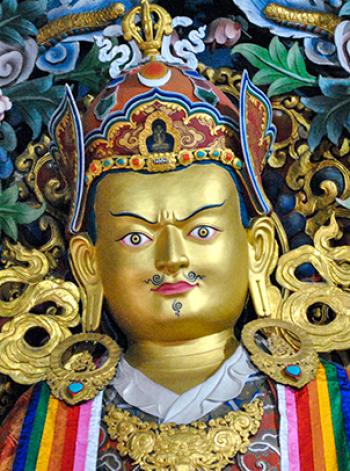
Religion: Buddhism
Title: Guru
Padmasambhāva, also known as Guru Rinpoche, is a seminal figure in the history of Tibetan Buddhism. Credited with introducing Tantric Buddhism to Tibet in the 8th century, he was invited to the region by Tibetan King Trisong Detsen to help establish Buddhism in the region.
Tibetan lore recounts that Padmasambhāva subdued local deities and spirits, converting them to Buddhism. This helped in integrating the indigenous Bon religion with incoming Buddhist traditions.
With King Trisong Detsen and the Buddhist abbot Shantarakshita, Padmasambhāva founded Samye, the first Buddhist monastery in Tibet, marking a significant turning point in Tibetan religious history.
Padmasambhāva is said to have hidden numerous terma (spiritual treasures) throughout Tibet, Bhutan, and the Himalayas. These are meant to be discovered by tertons (treasure finders) at appropriate times in the future, providing teachings suited for those specific times.
Padmasambhāva is believed to reside in the Copper-Colored Mountain, a pure land where he continues to teach to this day. He's considered an eternal figure who can be invoked and called upon for blessings, guidance, and protection.
Padmasambhāva's teachings and influence are foundational for the Nyingma school of Tibetan Buddhism, the oldest of the four major traditions. His impact, however, extends across all Tibetan Buddhist schools, and his veneration as Guru Rinpoche is widespread.
Padmasambhāva was instrumental in firmly establishing Buddhism in Tibet, blending it with local traditions and ensuring its continued relevance through the terma tradition. His legacy persists as a central figure of devotion and reverence in Tibetan Buddhism.
Gorakhnath (circa 11th Century)

Religion: Hinduism (Nath Sampradaya)
Title: Saint, Yogi, Founder of Nath Hindu Monastic Movement
Gorakhnath was an influential saint and yogi in the Indian subcontinent. He is traditionally regarded as the founder or leading figure of the Nath tradition.
Gorakhnath is closely associated with the Nath Sampradaya, a Shaivite sect, which places emphasis on yoga, asceticism, and inner spiritual realization. The sect was particularly influential in northern India. He is credited with authoring several foundational texts on Hatha Yoga, a form of yoga focusing on physical postures and purification techniques.
Many legends are associated with Gorakhnath, emphasizing his yogic powers, his compassion, and his role as a spiritual guide. He is often portrayed as having performed miracles.
Gorakhnath is believed to be a disciple of Matsyendranath, another revered figure in the Nath tradition. This guru-disciple lineage is important in the Nath Sampradaya.
Gorakhnath Math is a monastery named after him, with branches in both Gorakhpur and Puri. It plays a significant role in the spiritual, cultural, and social life of the regions where they're located.
Apart from his contributions to yoga and the spiritual traditions of India, Gorakhnath also impacted regional literature and culture. His teachings and the legends associated with him can be found in various languages across India and Nepal.
Gorakhnath is remembered as a pivotal figure in North Indian spirituality, particularly within the Nath sect. His teachings continue to inspire many on the path of yoga and spiritual realization.
Ramanuja (1017-1137)
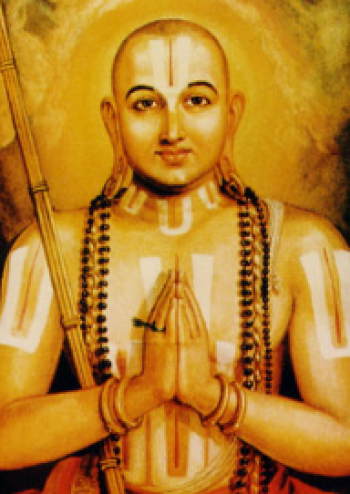
Religion and Branch: Hinduism
Title: Theologian, Philosopher, Guru, Reformer
Ramanuja was a renowned Indian theologian and philosopher, primarily known for his contributions to the Visishtadvaita (qualified non-dualism) tradition of Vedanta within Hinduism. His teachings and philosophy hold significant importance in the religious landscape of India.
Ramanuja's philosophical stance, known as Visishtadvaita (meaning "Qualified Non-dualism"), posits that while the divine is essentially one, it is also characterized by multiplicity. In this view, souls and the material world are real and are essential qualities of Brahman, the ultimate reality. This stands in contrast to the Advaita Vedanta's absolute monism.
Ramanuja emphasized devotion as the path to salvation, with Lord Vishnu (or Narayana) as the central deity. He believed that liberation is achieved through surrender and devotion to Vishnu.
Ramanuja advocated against caste-based discrimination. He held the view that devotion to God is available to everyone regardless of their caste, breaking traditional barriers that restricted religious activities and teachings to the upper castes.
Ramanuja wrote several influential texts, including commentaries on Brahmasutras and Bhagavad Gita. His works provided a systematic exposition of Visishtadvaita Vedanta. He also established multiple monastic centers and temples, fostering the growth and institutionalization of the Sri Vaishnavism tradition, which follows his teachings.
Ramanuja's teachings became foundational for the Sri Vaishnavism tradition. This tradition remains one of the major schools of devotional Hinduism, with a vast following, especially in South India.
Ramanuja's contributions to Indian religious thought were profound. His distinctive philosophical insights into the nature of the divine, combined with his emphasis on devotion and his efforts towards social inclusivity, have cemented his position as one of the stalwart theologians and philosophers in the history of Hinduism.
Mir Sayyid Ali Hamadani (circa 1312-1384)
Religion and Branch: Islam (Sufism)
Title: Sufi Saint, Islamic Scholar, Missionary
Mir Sayyid Ali Hamadani, also known as Shah Hamadan, is a revered Islamic scholar and Sufi saint. Particularly famous for his role in spreading Islam to the Kashmir Valley.
Born in Hamadan, Persia (modern-day Iran), Hamadani belonged to a noble and learned family. His lineage is traced back to the Prophet Muhammad, making him a Sayyid (a title given to the descendants of the Prophet).
As a prominent Sufi, Hamadani's teachings focused on love, devotion, and the internal aspects of Islam. He emphasized the esoteric dimensions of the faith and advocated for a personal and direct experience of God through mysticism.
While Islam had made inroads into the Kashmir Valley before his arrival, Mir Sayyid Ali Hamadani is often credited with consolidating its presence there. He, along with his 700 followers (often referred to as "the 700 Sayyids"), made a significant impact on the religious landscape of Kashmir. His peaceful means of propagation, combined with his spiritual teachings, attracted many to Islam.
Apart from his missionary work, he was an accomplished writer and scholar. His most famous work is , a treatise that deals with various subjects including theology, governance, ethics, and more. His writings played a crucial role in the intellectual and spiritual development of Muslims in the region.
Beyond his strictly religious influence, Mir Sayyid Ali Hamadani also left a profound cultural and socio-economic mark on Kashmir. He introduced Persian arts, crafts, and traditions to the region. For instance, the art of making Pashmina shawls, which is a significant craft in Kashmir, is said to have been introduced by him.
Hamadani is remembered and revered not only as a spiritual leader but also as a social reformer in Kashmir. He played a critical role in shaping the religious and cultural landscape of the region. Many mosques and shrines dedicated to him can be found in Kashmir, underscoring his lasting legacy.
Hamadani's impact on the religious and cultural life of Kashmir was profound. Through his teachings, writings, and personal example, he left an indelible mark on the region, the effects of which can still be seen today.
Kabir (1398-1518)
Religion and Branch: Hinduism and Islam (Sufism)
Title: Saint, Mystic
Kabir was a renowned poet-saint of India whose verses have had a profound impact on the Bhakti Movement, a devotional movement in India that sought personal union with the divine. He is often depicted with his disciple, Dharamdas, symbolizing the guru-disciple relationship that's central to many spiritual traditions in India.
Kabir is unique in that he is revered by Hindus, Sikhs, and Sufis alike. His teachings and poetry often blended elements from various religious traditions, especially Hinduism and Islam. This syncretic approach made him a symbol of religious unity and tolerance in India.
Kabir was critical of ritualistic practices in both Hinduism and Islam. He emphasized personal devotion to God rather than ritualistic practices and institutionalized religious dogma. His verses often mock ritualistic practices and stress the importance of heartfelt devotion.
Kabir's poetic verses, often in the form of couplets, are known for their simplicity, depth, and clarity. They cover various aspects of life and spirituality and offer profound insights into the nature of God, soul, and the world. Kabir's verses found their way into the Guru Granth Sahib, the primary scripture of Sikhism, highlighting his significant influence on the Sikh tradition. Additionally, his works are foundational texts in the Sufi and Sant traditions.
One of the recurring themes in Kabir's teachings is the oneness of humanity and the universal brotherhood of all beings. He often spoke against caste discrimination and religious divisions, emphasizing instead the unity of all in the eyes of God.
Kabir is one of the most influential saints in India's religious history. His teachings, which transcend religious boundaries, have been a beacon of unity, love, and devotion. He played a pivotal role in shaping the Bhakti Movement, emphasizing a direct and personal relationship with the divine, bypassing the rigidity of religious institutions and dogmas.
Srimanta Sankardev (1449-1568)
Religion and Branch: Ekasarana Dharma
Title: Saint, Scholar, Reformer, Writer
Srimanta Sankardev was a profound cultural and religious icon in the Assam region of India. He is chiefly credited with laying the foundation for a new cultural-religious ethos known as Neo-Vaishnavism.
Sankardev was the primary proponent of the Bhakti movement in Assam and founded the Neo-Vaishnavism tradition. This religious tradition centered on the worship of Lord Krishna and promoted devotion (bhakti) as the primary means to salvation.
Sankardev emphasized an egalitarian approach to religion, seeking to transcend the barriers posed by caste and creed. His teachings were inclusive, attracting followers from various social backgrounds, and working against caste-based discrimination.
Sankardev translated and adapted significant parts of the Bhagavata Purana into Assamese, making these religious texts more accessible to the common people of Assam. His literary works play a foundational role in Assamese literature.
Beyond his religious contributions, Sankardev was also a towering figure in Assamese culture. He made substantial contributions in the fields of music, dance, and drama, introducing new art forms like Borgeet (devotional songs), Sattriya Nritya (classical dance), and Ankiya Naat (one-act plays).
Sankardev established monastic centers called 'Satras' which became the epicenters of Neo-Vaishnavism in Assam. These Satras played a dual role: they were religious centers that propagated the Neo-Vaishnavism doctrine, and they also became hubs of cultural activity, promoting the art forms Sankardev had introduced.
Sankardev's influence can still be felt strongly in Assam. The Neo-Vaishnavism tradition he established has millions of followers and continues to shape Assamese culture, art, and religious practices.
Sankardev was a transformative figure in Assam's religious, cultural, and social landscape. He introduced and solidified a unique form of Vaishnavism and was a pivotal force behind a cultural renaissance in the region, making him one of the most revered personalities in Assam and an influential figure in the broader religious history of India.
Chaitanya Mahaprabhu (1486-1534)
Religion and Branch: Hinduism
Title: Saint
Chaitanya Mahaprabhu was a prominent figure in the Bhakti Movement in India and is primarily known for propagating the worship of Lord Krishna and introducing the practice of Sankirtan, congregational chanting of the holy names of the deity.
Mahaprabhu is considered the founder of the Gaudiya Vaishnavism tradition, which worships Lord Krishna in the mood of Radha, his consort, focusing on their divine love. This tradition has a profound influence in the regions of Bengal, Orissa, and northeastern India.
Mahaprabhu popularized the practice of Sankirtan, or the congregational chanting of the Hare Krishna maha-mantra. This practice was seen as a universal method for attaining love of God, transcending the barriers of caste, creed, and religion.
Mahaprabhu's devotion to the divine couple, Radha and Krishna, was intense and ecstatic. He is often considered an incarnation of Radha and Krishna combined. His teachings focused on deep emotional devotion and the stages of divine love.
Mahaprabhu's movement was inclusive, disregarding caste distinctions and orthodox ritualistic practices. He accepted disciples from various social backgrounds, challenging the rigid Brahminical orthodoxy of his time.
Though Mahaprabhu himself did not pen many texts, his followers, especially the six Goswamis of Vrindavan, wrote foundational texts for the Gaudiya Vaishnavism tradition, elucidating its theology and practices.
Gaudiya Vaishnavism has spread globally, in part due to the efforts of the International Society for Krishna Consciousness, whose founder, A.C. Bhaktivedanta Swami Prabhupada, regarded Mahaprabhu as the most recent incarnation of Lord Krishna.
Mahaprabhu's influence on the religious landscape of India, particularly in fostering devotion to Radha and Krishna and in emphasizing the importance of heartfelt bhakti (devotion) over ritualistic practices, has been profound. His legacy continues to shape the lives and beliefs of millions of devotees worldwide.
Mirabai (circa 1498 to circa 1547)
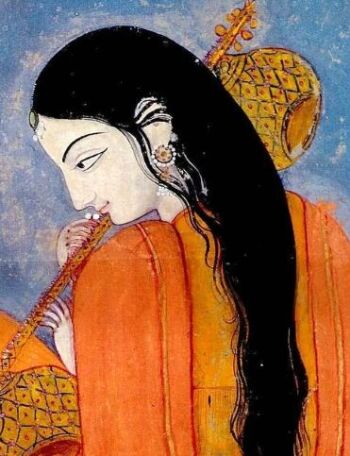
Religion and Branch: Hinduism
Title: Saint, Mystic, Poet
Mirabai was a prominent Hindu mystic, poet, and devotee of Lord Krishna. She is one of the most celebrated figures in the bhakti (devotional) movement of India.
Mirabai's unwavering devotion to Lord Krishna is legendary. She considered herself to be a gopi (meaning "a female lover") of Krishna and him to be her eternal beloved. Her life and poetry vividly express this intense love and longing for the divine.
Mirabai's compositions, mostly in the form of bhajans (devotional songs), are simple yet profound expressions of love for Krishna. They often depict her deep spiritual emotions, challenges in her personal life due to her devotion, and her unwavering faith in Krishna.
As a Rajput princess, Mirabai broke many societal norms of her time. Her decision to forsake the comforts of the palace, disregard her duties as a princess, and challenge the traditional role of women in her society underlines her extraordinary commitment to her spiritual path.
Mirabai's life is seen as a symbol of spiritual liberation, especially for women. Her dedication to Krishna, despite facing social ostracization and even threats to her life, serves as a testament to the power of unwavering faith.
Over the centuries, Mirabai has become an iconic figure representing the bhakti movement. Her songs, still widely sung across India, resonate with people of various backgrounds and beliefs, emphasizing a personal connection with the divine over ritualistic practices.
The life and works of Mirabai have inspired countless pieces of art, music, dance, and literature over the centuries. Her story and songs have been adapted into films, plays, and dance dramas.
Mirabai is celebrated as one of the foremost saints of the bhakti movement in India. Her deep devotion to Lord Krishna, expressed through her poignant poetry and defiance of societal norms, has left a lasting imprint on the spiritual and cultural landscape of India.
Francis Xavier (1506-1552)
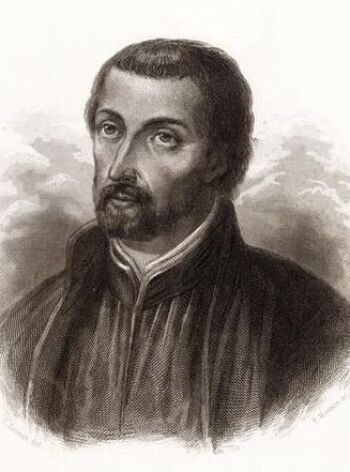
Religion and Branch: Christianity (Catholicism)
Title: Missionary, Cofounder of Society of Jesus
Born Francisco de Jasso y Azpilicueta, Francis Xavier was a pioneering Roman Catholic missionary and a co-founder of the Society of Jesus (Jesuits). His missionary activities in India marked a significant chapter in the history of Christianity in the subcontinent. In 1542, he arrived in Goa, a Portuguese colony, initiating his missionary efforts in India.
Xavier traveled extensively along the western coast of India, establishing Christian communities, converting many, particularly among the lower castes and the fishing communities. He was known for his personal discipline, fervor, and charisma, which attracted many to the Christian faith.
Goa became the primary base for Xavier's evangelistic campaigns. He played a pivotal role in setting up institutions and churches, including the famous St. Paul's College, which became a crucial center for Jesuit activity in Asia.
While his contributions to Christianity in India were significant, Xavier's mission extended beyond India to other parts of Asia, including Malacca, the Moluccas, and Japan. Nonetheless, India remained central to his broader evangelization strategy.
Xavier is remembered for his untiring missionary zeal and his contributions to establishing the Catholic Church's foothold in India. His efforts laid the groundwork for subsequent Jesuit and Catholic missions in India and other parts of Asia.
Recognizing his impactful evangelical work, Xavier was canonized as a saint by the Roman Catholic Church in 1622. The Basilica of Bom Jesus in Goa houses his relics and is a UNESCO World Heritage site, drawing pilgrims and tourists from around the world.
Xavier stands as a towering figure in the history of Christianity in India. His missionary activities in the 16th century laid foundational structures for the growth of the Catholic Church in the region, and his legacy continues to influence Christian communities in India today.
Tulsidas (1511-1623)
Religion and Branch: Hinduism
Title: Saint, Poet
Tulsidas was a prominent Hindu saint and poet, renowned for his writings on Lord Rama. He played a pivotal role in the religious landscape of India, particularly in popularizing the devotional (bhakti) movement focused on Rama.
Tulsidas' magnum opus, "The Lake of the Deeds of Rama," is an epic poem in Awadhi dialect of Hindi. It narrates the life story of Lord Rama. The text is widely considered the most important piece of literature in Hindi and has deeply influenced the culture and spirituality of northern India. Tulsidas wrote several other works such as "Dohavali," "Kavitavali," and "Hanuman Chalisa," a devotional hymn dedicated to Lord Hanuman. These works further establish his stature as a spiritual luminary.
Tulsidas was a significant figure in the bhakti movement, which emphasized personal devotion over ritualistic practices. His writings and hymns reinforced the message of love, devotion, and surrender to God, in this case, specifically to Rama. Tulsidas's portrayal of Rama not just as a divine figure but also as an ideal human being had a significant influence on shaping the moral and ethical values of society.
By choosing to write in the vernacular Awadhi language instead of Sanskrit, which was the scholarly and liturgical language of the time, Tulsidas made his works, and thereby the story of Rama, more accessible to the common people.
Tulsidas' influence endures in contemporary India. His works are recited and revered across North India, and many festivals, such as Ramlila (a dramatic re-enactment of the life of Rama), derive inspiration from the Ramcharitmanas.
Tulsidas was a seminal figure in the religious and cultural history of India. His devotion to Rama, expressed through his writings, has left an indelible mark on the spiritual consciousness of millions of Hindus over the centuries.
Gobind Singh (1666-1708)
Religion and Branch: Sikhism
Title: Guru, Writer
Gobind Singh was the 10th and final Guru of Sikhism, a major religious and cultural force in India. His leadership had profound effects on the development and shaping of the Sikh faith.
In 1699, Guru Singh founded the Khalsa, a community of baptized Sikhs, to uphold the tenets of Sikhism and resist oppression. Initiates to the Khalsa were given the surname Singh (meaning "lion") for men and Kaur (meaning "princess") for women, symbolizing equality and empowerment. While Guru Singh strongly established Sikh distinctiveness with the creation of the Khalsa, he also emphasized the oneness of God and the universal nature of spirituality, which transcends religious and social divisions.
Guru Singh introduced the Five Ks, or the five articles of faith, that baptized Sikhs are expected to embody in their everyday lives. These are Kesh (uncut hair), Kara (a steel bracelet), Kanga (a wooden comb), Kachera (cotton undergarments), and Kirpan (a ceremonial sword).
Guru Singh was a prolific writer and poet. One of his most notable contributions is the "Dasam Granth," a collection of religious and secular writings.
In a time of religious persecution, Guru Singh was not just a spiritual leader but also a warrior who defended his community against Mughal forces and other hostile groups. He inspired Sikhs to be both saints and soldiers.
Before his death, Guru Singh declared that there would be no more human gurus after him. He designated the Guru Granth Sahib, the central religious scripture of Sikhism, as the eternal guru for Sikhs. This was a monumental step in defining the spiritual direction of the faith.
Guru Singh's impact on Sikhism and the broader religious landscape of India is immeasurable. His teachings and the institutions he established have shaped the identity and direction of Sikhism. He played a crucial role in defining Sikhism as it is known today. His leadership, teachings, and the institutions he established have had a lasting impact on the spiritual, social, and cultural fabric of India, particularly within the Sikh community.
Shah Waliullah Dehlawi (1703-1762)
Religion and Branch: Sunni Islam (Sufism)
Title: Islamic Scholar, Theologian, Reformer
Shah Waliullah Dehlawi was a prominent Islamic scholar, theologian, and reformer in 18th-century India. Born in Delhi during the decline of the Mughal Empire, he hailed from a family of scholars and received his early education from his father, Shah Abdur Rahim, the author of the Hanafi fiqh compendium, Fatawa-e-Rahimiyyah.
Dehlawi emphasized the need for a revival of Islamic teachings and practices at a time when India's Muslim community faced both internal divisions and external pressures. He believed in a return to the Quran and Sunnah as primary sources of authority.
Recognizing the linguistic changes in India, Dehlawi translated the Quran into Persian, which was the lingua franca of the Indian elite at the time. This was one of the earliest translations of the Quran into a South Asian language, aimed at making the holy text accessible to the broader population.
Dehlawi was a prolific writer, penning works on Islamic theology, philosophy, ethics, and history. His most famous work, The Conclusive Argument from God, is an intellectual synthesis of Islamic thought.
Dehlawi called for societal and educational reforms and emphasized the importance of ijma (consensus) and ijtihad (independent juristic reasoning) in Islamic jurisprudence. He sought to bridge the differences between various Muslim groups and was a strong critic of sectarianism.
Dehlawi's efforts laid the foundation for subsequent Islamic movements and scholarship in India. His students and followers, including his own sons, played pivotal roles in religious, educational, and socio-political spheres in India and beyond. He as a beacon of Islamic scholarship and reform during a tumultuous period in Indian history. His emphasis on returning to core Islamic principles, along with his advocacy for unity and revivalism, has left an enduring legacy in South Asian Islam.
Ram Mohan Roy (1772-1833)

Religion and Branch: Hinduism
Title: Reformer
Raja Ram Mohan Roy was a prominent socio-religious reformer in India during the early 19th century and is often referred to as the Father of the Indian Renaissance.
Roy is best known for founding the Brahmo Samaj in 1828. This socio-religious organization aimed to promote a form of monotheistic Hinduism while purging it of practices and beliefs that Roy considered superstitious or regressive, such as idol worship and the caste system.
Roy was well-versed in multiple religious traditions, including Hinduism, Islam, and Christianity. He believed in the fundamental unity of all religions and emphasized monotheism. His interpretation of Hindu scriptures, especially the Upanishads, highlighted their monotheistic essence.
One of Roy's most significant achievements was his campaign against the practice of sati (the self-immolation of widows on their husband's funeral pyre). His efforts, combined with those of other reformers, led the British authorities to outlaw the practice in 1829.
Roy believed that India's progress was linked to its exposure to Western education and science. He championed the cause of English education and modern subjects, leading to the establishment of several English schools and colleges.
Roy wrote extensively on Hindu scriptures, offering interpretations that countered orthodox views and highlighted rational and moral principles. His works, emphasizing reason and morality, aimed to bring about a rationalistic revival of Hinduism.
While he collaborated with the British colonial authorities on specific reforms (like the abolition of sati), he also criticized them when needed, especially on matters of revenue collection and the drain of wealth from India.
Roy played a pivotal role in reshaping the religious and intellectual landscape of India during the 19th century. He sought to harmonize India's rich spiritual traditions with the rational and progressive ideals of the West. His efforts laid the groundwork for various socio-religious reform movements in India and paved the way for a modern and progressive Indian society.
Henry Martyn (1781-1812)

Religion and Branch: Christianity (Anglican)
Title: Priest, Missionary
Henry Martyn was an Anglican priest and missionary. Born in Truro, Cornwall, England, he was initially focused on a career in law. However, under the influence of Charles Simeon, he became committed to missionary work.
In 1806, Martyn traveled to India as a chaplain for the East India Company. During his time there, he engaged in missionary activities, including evangelism and translating the New Testament into Urdu and Persian.
In addition to his translations of the New Testament, Martyn also translated the Anglican liturgy and the Book of Common Prayer into Persian. His linguistic abilities enabled him to make these contributions despite his relatively short time in the mission field.
Martyn later traveled to Persia (modern-day Iran), aiming to further his translation efforts. There, he completed a translation of the New Testament into Persian, which remains an important text for Persian-speaking Christians.
Martyn had several discussions and debates with Muslim scholars. He aimed to understand Islam better and find common ground while also arguing for the veracity of Christianity.
Martyn died at the young age of 31 in Tokat, in the Ottoman Empire (modern-day Turkey). His dedication and tireless work in such a short lifespan made a significant impact on missionary efforts in the regions where he served.
Martyn is remembered as a passionate and devoted missionary who bridged cultures and languages in his dedication to spreading the Christian faith. Henry Martyn Institute in Hyderabad, India, which promotes interfaith understanding and relations, is named in his honor. He exemplified the spirit of 19th-century Christian missionary efforts, marked by both dedication to the Gospel and a genuine interest in engaging with and understanding other cultures and faiths.
Syed Ahmad Barelvi (1786-1831)
Religion and Branch: Islam (Sunni)
Title: Islamic Scholar, Military Leader
Syed Ahmad Barelvi, also known as Sayyid Ahmad Shahid, was an Islamic reformer and jihadist in the Indian subcontinent during the late 18th and early 19th centuries.
Barelvi sought to revive and purify Islam from what he perceived as innovations (bid'ah) and un-Islamic practices that had crept into the beliefs and practices of Indian Muslims. He emphasized a return to the fundamentals of the Quran and Hadith (sayings and actions of Prophet Muhammad).
Barelvi was instrumental in the formation of the Tariqa-i Muhammadiya movement, which aimed at the religious and moral reform of Muslims. This movement attracted followers from various parts of the subcontinent.
Concerned about the decline of Muslim political power in India and the rise of Sikh power in the Punjab region, Syed Ahmad declared a jihad (holy war) against the Sikh Empire. He aimed to establish an Islamic state based on Sharia law in the region. His jihadist movement attracted numerous followers, mainly from the Afghan frontier and the regions of modern-day Uttar Pradesh and Bihar.
In 1831, Syed Ahmad Barelvi and his close associate, Shah Ismail, were defeated and killed in the battle of Balakot by Sikh forces. His martyrdom led to him being revered by many of his followers and subsequent Islamic movements in South Asia.
The efforts of Barelvi laid the groundwork for future Islamic reform movements in the Indian subcontinent. His emphasis on a more austere and fundamental interpretation of Islam influenced the Deobandi school and other Islamic reform movements in the region. However, his jihadist approach and the aspiration for an Islamic state also sparked debates among South Asian Muslim scholars about the right course for Muslim politics in the region.
Barelvi was a significant figure in the religious history of India, especially in the context of Islamic revivalism. His efforts to purify and strengthen Islamic practices among Indian Muslims and his vision of an Islamic political order left a lasting impact on subsequent generations and movements.
Syed Ahmed Khan (1817-1898)
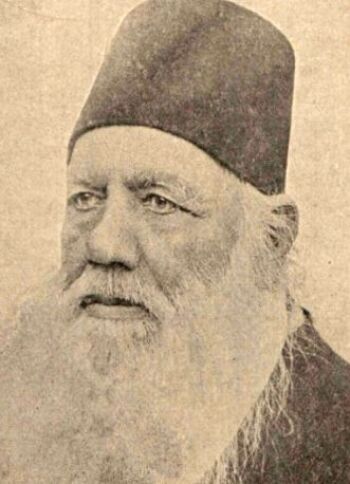
Religion and Branch: Islam
Title: Philosopher, Educator, Writer, Reformer
Sir Syed Ahmed Khan was a prominent reformer, educator, and jurist in 19th-century India. While he is best known for his educational and social reforms aimed at uplifting the socio-economic conditions of Muslims in India, his contributions to religious thought and understanding are also noteworthy.
Khan believed in a rational approach to Islam. He felt that the Quran did not oppose reason or science, and he argued against literal interpretations of the scriptures that seemed to contradict established scientific facts or logic. He was influenced by modernist and reformist ideas, especially from the West.
Khan was a strong proponent of modern education. He emphasized that Muslims should embrace modern science and technological advancements without feeling that these conflicted with Islamic teachings. He felt that the decline of Muslims in India was due to their neglect of modern education and that there was no inherent conflict between Islam and the modern sciences.
Apart from his writings on the Quran and Hadiths, Khan wrote a commentary on the Bible wherein he tried to show the similarities between Islam and Christianity, aiming to promote mutual respect between the two religious communities.
Khan was critical of the blind following (taqlid) of religious scholars without understanding the essence or reasoning behind religious dictates. He believed that it was essential for Muslims to understand their religion rationally.
While this is more socio-educational than religious, it's worth noting that Khan's most significant contribution was the foundation of the Muhammadan Anglo-Oriental College in Aligarh in 1875, which later became Aligarh Muslim University. The institution was established to modernize the Muslim community's education, bringing them in line with the global standards of his time, and ensuring that they could compete on an equal footing with other communities in India.
In the broader context of 19th-century India, Khan's religious views and actions should be seen in the light of his overarching concern for the socio-economic upliftment of Muslims. He believed that religious modernism and an embrace of science and reason were essential for the progress of the Muslim community. While his views were progressive and aimed at reform, they also attracted criticism from more conservative sections of the Muslim community. Regardless, his impact on the religious, social, and educational landscape of Indian Muslims is profound and lasting.
Ramalinga Swamigal (1823-1874)
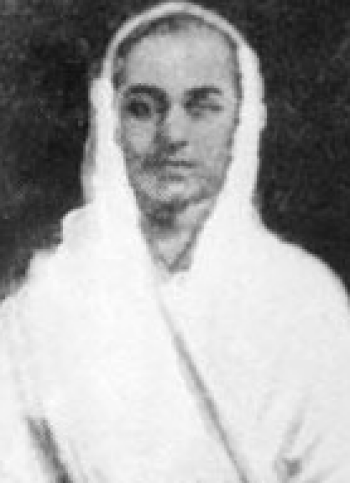
Religion and Branch: Hinduism (Shaiva Siddhanta)
Title: Tamil Saint, Poet, Philosopher
Ramalinga Swamigal, born as Thiruvarutprakasa Vallalār Chidambaram Ramalingam and commonly known as Vallalar, was a prominent Tamil saint, poet, and philosopher in the 19th century. His contributions to religion and spirituality in India, especially in the Tamil region, are significant.
Vallalar preached the idea of a universal brotherhood and the equality of all religions. He advocated for the worship of a supreme being irrespective of individual religious beliefs. One of his core teachings was compassion towards all living beings. He strongly opposed animal sacrifices and propagated vegetarianism.
In Vadalur, Vallalar established Sathya Dharma Salai, a free eating house where all were welcome regardless of caste or creed, emphasizing his commitment to eradicating hunger and promoting social equality.
Vallalar composed the magnum opus Holy Book of Grace, which is considered a spiritual classic in Tamil literature. This six-part work emphasizes the essence of human compassion and love towards all living beings.
Many miracles are attributed to Vallalar. Toward the end of his life, it's believed he dematerialized his physical body to merge with the Divine, emphasizing his teachings on the possibility of achieving spiritual liberation in one's lifetime.
Vallalar's teachings, although rooted in the Tamil and Indian context, have universal relevance. His message of compassion, universal love, and the emphasis on the inner spiritual path over ritualistic practices has continued to inspire generations.
Vallalar is a significant figure in the spiritual and religious landscape of India, particularly in Tamil Nadu. His teachings and works continue to resonate, emphasizing love, compassion, and spiritual oneness.
Dayanand Saraswati (1824-1883)
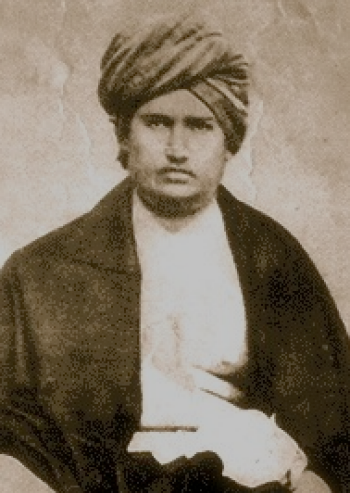
Religion and Branch: Hinduism
Title: Philosopher, Founder of Arya Samaj Movement
Dayanand Saraswati was an important religious and social reformer in India. He is best known for founding the Arya Samaj, a Hindu reform movement, and for his emphasis on a return to the Vedas as the ultimate source of truth and righteousness.
In 1875, Saraswati founded the Society of Nobles, which aimed to reform and revitalize Hinduism. The movement rejected the prevailing practices of idol worship, caste by birth, and the emphasis on rituals, promoting instead Vedic values and principles.
Saraswati's rallying cry was "Back to the Vedas!" He emphasized the authority of the Vedas, the oldest Hindu scriptures, and believed that all religious and social practices should be tested against them. He rejected later texts, particularly the Puranas, which he viewed as corrupted and promoting superstitions.
A significant aspect of Saraswati's teachings was the rejection of idol worship. He believed that God is formless and idol worship was a deviation from the true teachings of the Vedas. He was a proponent of the Hindi language, advocating for its use over Persian and English in schools and government.
Apart from religious reforms, Saraswati was a strong advocate for various social reforms. He spoke out against the caste system and untouchability, advocated for the education of women, and was against child marriage and the practice of self-immolation of widows.
The Arya Samaj movement played a crucial role in shaping the socio-religious thought of India in the late 19th and early 20th centuries. It paved the way for other reform movements and played a role in the Indian independence struggle by promoting a sense of pride in Indian culture and heritage.
Dayanand's emphasis on rational thinking and a return to the original scriptures of Hinduism inspired many future leaders and thinkers. His works, including Light of Truth, continue to be studied and respected by followers and scholars.
Saraswati was a towering figure in 19th-century India, whose efforts at religious and social reform left a lasting impact on Indian society and the course of Hinduism. He played a pivotal role in challenging prevalent socio-religious norms and introducing progressive changes in the Indian religious landscape.
Hassan Ali Effendi (1830-1895)

Religion and Branch: Islam
Title: Educator
Hassan Ali Effendi is best known for his significant contributions to education in India, particularly for the Muslim community during the British Raj.
In 1885, Effendi founded Sindh Madressatul Islam in Karachi, which was then part of British India and is now in Pakistan. This institution was established to offer modern education to the Muslim community while also providing instruction in Islamic studies. Effendi's vision was to bridge the gap between traditional Islamic education and modern sciences and humanities. The institution aimed to produce graduates who were well-versed in their religious duties and teachings and also equipped with knowledge beneficial for contemporary society.
The establishment of Sindh Madressatul Islam was a crucial step in promoting modern education among Muslims in the region. It was among the first educational institutions that attempted to harmonize religious teachings with modern subjects, preparing students for challenges of the modern world.
Effendi's vision continued to have a lasting impact. Sindh Madressatul Islam evolved over the years, and it became Sindh Madressatul Islam University in the 21st century. This institution has played a role in producing many notable alumni, including Pakistan's founder, Muhammad Ali Jinnah.
While Effendi is primarily known for his educational endeavors, his efforts stemmed from a deeper understanding of the importance of education within Islamic teachings. He believed that acquiring knowledge was a religious duty and essential for the betterment of the Muslim community.
Effendi is a significant figure in the educational history of British India, particularly for his efforts to modernize and promote education within the Muslim community. His work in establishing and promoting institutions such as Sindh Madressatul Islam had profound implications for the educational and religious landscape of the region.
Ramakrishna Paramahansa (1836-1886)
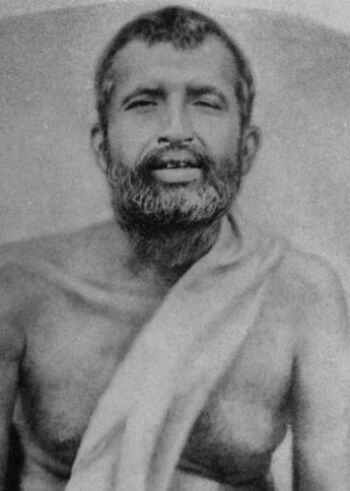
Religion and Branch: Hinduism
Title: Spiritual Leader, Mystic
Ramakrishna Paramahansa was an influential Indian mystic and spiritual leader of the 19th century. His religious experiences and teachings had a profound impact on the spiritual landscape of India.
Paramahansa is celebrated for his universal approach to spirituality. He practiced various paths of Hinduism like Vaishnavism, Shaktism, and Vedanta, as well as non-Hindu traditions like Islam and Christianity. He often said, Joto Mot, Toto Poth meaning "as many beliefs, so many paths," underscoring the validity of multiple religious paths to the divine.
Paramahansa emphasized the importance of God-realization as the ultimate goal of life. He believed that sincere longing and yearning were enough to attain this realization, regardless of the religious path chosen.
Paramahansa spent a significant part of his life at the Dakshineswar Kali Temple near Kolkata, where he served as the chief priest. His spiritual experiences and teachings at the temple attracted a significant number of seekers and disciples.
Among Paramahansa's disciples, the most renowned was Swami Vivekananda. Paramahansa's teachings profoundly influenced Vivekananda, who later established the Ramakrishna Mission to spread his master's teachings and undertake humanitarian works.
Paramahansa had a deep devotional relationship with the goddess Kali. He viewed her as both the Universal Mother and the ultimate reality, often going into spiritual ecstasies during his prayers.
Paramahansa's teachings emphasized the universality of spiritual truths underlying all religions. His life and teachings continue to inspire millions of followers worldwide and have been the subject of numerous studies, books, and philosophical discussions.
Paramahansa stands as a symbol of the universality of religious experience, emphasizing the possibility of God-realization through various paths. His teachings have played a pivotal role in promoting interfaith understanding and harmony, making him one of the most revered figures in India's spiritual history.
Sai Baba of Shirdi (circa 1838-1918)
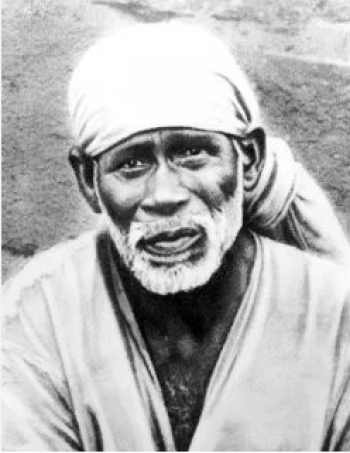
Religion and Branch: Hinduism, Islam
Title: Spiritual Leader
Sai Baba of Shirdi, commonly referred to as Shirdi Sai Baba, was an Indian spiritual leader who is regarded by his followers as a saint, ascetic, and incarnation of God. His teachings and practices drew from both Hindu and Islamic traditions. He lived in a mosque in Shirdi, which he referred to as Dwarkamai, and frequently quoted from both Hindu and Muslim scriptures.
Baba's teachings emphasized love, charity, inner peace, and devotion to the Guru and God. He advocated the moral code of love, forgiveness, helping others, contentment, inner peace, and devotion to God.
Baba was attributed with performing miracles, such as lighting lamps with water, healing the sick, and knowing the thoughts and pasts of others. These miracles increased his fame and drew devotees to him.
After his death, Baba left a lasting spiritual legacy. The Shirdi Sai Baba movement began to spread, drawing followers from various backgrounds and religions. The town of Shirdi, where Baba spent most of his life, has become one of the major pilgrimage sites in India. The Sai Baba temple in Shirdi is visited by millions every year.
Baba's teachings resonate with people from different faiths, making him a unifying figure in the diverse religious landscape of India. He often emphasized the oneness of God, regardless of religious distinctions, and is revered by followers of multiple religious traditions.
Baba's impact can also be seen in various cultural forms in India, including music, cinema, and literature, where he is frequently invoked or depicted. He stands as a symbol of religious unity and harmony in India. His teachings, which transcend religious boundaries, have left a profound impact, drawing countless devotees from various backgrounds and fostering interfaith understanding.
Pandita Ramabai Sarasvati (1858-1922)
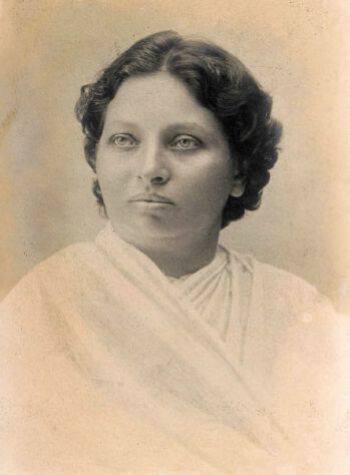
Religion and Branch: Hinduism Convert to Christianity
Title: Evangelist, Social Reformer, Scholar
Pandita Ramabai Sarasvati was a notable Indian evangelist, social reformer, scholar, and advocate for women's rights and education in the late 19th and early 20th centuries. Her journey in the religious landscape of India is quite remarkable.
Ramabai was born into a Brahmin family and was a Sanskrit scholar, a rare achievement for a woman at that time. Due to her proficiency in the language, she was given the titles of Pandita and Sarasvati after the Hindu goddess of knowledge.
Ramabai's search for spiritual truth led her to convert to Christianity in the late 19th century. This decision was influenced by various personal and intellectual reasons, including the death of close family members and her encounters with Christian scriptures.
After her conversion, Ramabai established the Mukti Mission in 1889, a refuge for young widows and destitute women. The mission aimed to provide them with education, vocational training, and spiritual guidance. Under the aegis of Mukti Mission, many women found shelter, hope, and new meaning in their lives.
One of Ramabai's significant contributions to Christianity in India was her translation of the Bible into Marathi, her mother tongue. Her deep familiarity with Sanskrit and other Indian languages enriched her translation.
Ramabai championed women's rights, especially in the context of education and social standing. She criticized the oppressive practices and beliefs that marginalized women, particularly within the traditional Hindu framework. Her Christian faith deeply influenced her advocacy, as she believed in the fundamental equality of all individuals.
Ramabai's work left a lasting impact on Indian society. Her mission paved the way for further reforms in women's education and social status. Moreover, her life is a testament to the synthesis of her Indian roots and her Christian beliefs, as she continuously strived to contextualize her faith within the Indian milieu.
Pandita Ramabai Sarasvati was a trailblazer in both the religious and social spheres of India. Her life and work serve as an enduring example of the power of faith to drive social change.
Swami Vivekananda (1863-1902)
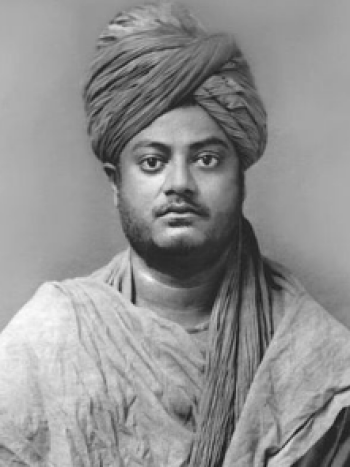
Religion and Branch: Hinduism (Vedanta)
Title: Monk, Philosopher, Writer, Educator
Swami Vivekananda was a Hindu monk and spiritual leader who played a significant role in introducing Indian philosophies of Vedanta and Yoga to the Western world. A key disciple of the mystic Ramakrishna Paramahamsa, he expanded and carried forward the teachings of his guru, emphasizing the universality of spiritual truths.
In 1893, Vivekananda delivered a historic speech at the Parliament of the World's Religions in Chicago. Addressing the audience as "Sisters and Brothers of America," he highlighted the importance of religious tolerance and the universality of spiritual teachings. His speech earned him widespread acclaim and recognition.
Through his travels in the West, Vivekananda worked tirelessly to spread the teachings of Vedanta and the value of Indian spirituality. He established the Vedanta Societies in the United States and England, bridging the gap between Eastern and Western religious philosophies.
Back in India, Vivekananda founded the Ramakrishna Mission, which is dedicated to the service of humanity and spiritual upliftment. The organization undertakes various charitable and educational activities while promoting the principles of Jiva is Shiva (meaning "every individual is divine") and that service to mankind is service to God.
Vivekananda emphasized the universality of spiritual truths, irrespective of religions. He believed in the potential divinity of the soul and stressed the importance of self-realization. His writings and lectures encompass a vast range of subjects, from spirituality to nation-building.
Vivekananda played a crucial role in awakening a sense of pride and nationalism among Indians, instilling confidence and encouraging them to believe in their rich cultural and spiritual heritage. His clarion call to the youth, "Arise, awake, and stop not till the goal is reached," continues to inspire generations.
Vivekananda was not just a spiritual leader but also a visionary who aimed to uplift humanity both spiritually and materially. His efforts in highlighting the profound depth of Indian spirituality and presenting it to the global audience made him one of the most iconic figures in India's religious history.
Copyright © 1993—2025 World Trade Press. All rights reserved.

 India
India